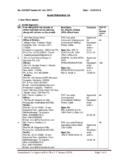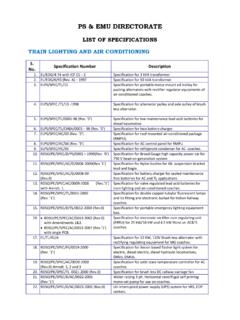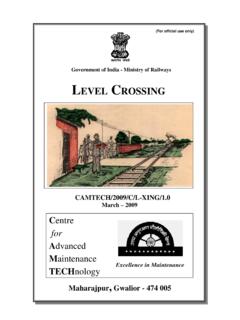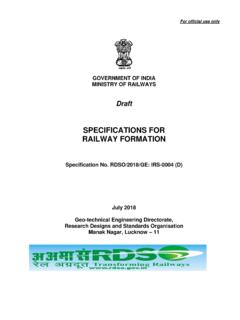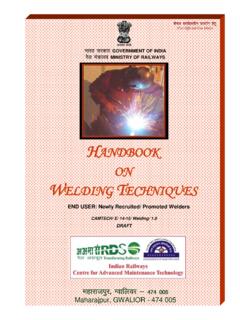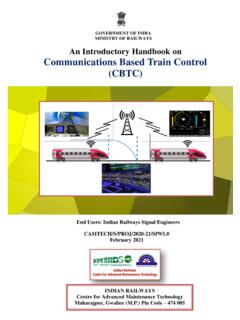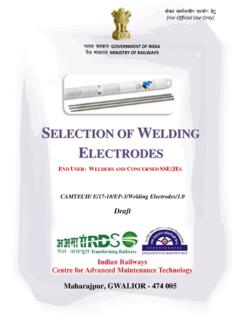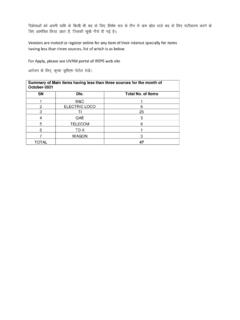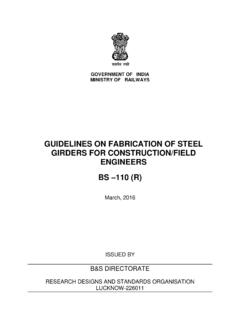Transcription of Handbook on Train Collision Avoidance System (TCAS) - An …
1 End Users: signal & Telecom. Engineers of Indian Railways INDIAN RAILWAYS Centre for Advanced Maintenance Technology Maharajpur, Gwalior ( ) Pin code 474 005 Handbook on Train Collision Avoidance System (TCAS) - An Indigenous ATP System CAMTECH/S/PROJ/2020-21/SP10 April 2021 GOVERNMENT OF INDIA MINISTRY OF RAILWAYS i This page has been left blank intentionally ii Handbook on Train Collision Avoidance System (TCAS) - An Indigenous ATP System CAMTECH/S/PROJ/2020-21/SP10 April 2021 iii This page has been left blank intentionally iv Foreword The focus of the Indian Railways is to increase capacity utilization of existing assets including rolling stock, track infrastructure, traction power and signalling & telecommunications. By running more high speed trains on the existing infrastructure, passengers and freight carrying capacity as well as revenue and profitability can be increased.
2 In order to ensure safety over high speed and high density rail networks of Indian Railways it is the need of the hour to implement Automatic Train Protection (ATP) System such as Train Collision Avoidance System (TCAS). Indian Railways have taken up indigenous development of Train Collision Avoidance System (TCAS) through Research Designs & Standards Organization (RDSO) to prevent dangerous Train collisions caused due to human errors or limitations and equipment failures by providing additional layer of enhanced safety in the operations. CAMTECH has issued this introductory Handbook on the subject for signal & Telecommunication engineers to help them in enhancing their knowledge about TCAS. As this is a new technology, the information given in this Handbook may be subsequently revised after gaining further experience.
3 I hope that this Handbook will be helpful to S&T engineers of Indian Railways in understanding the concept of ATP and TCAS. I wish them all the success. CAMTECH Gwalior Jitendra Singh Principal Executive Director v This page has been left blank intentionally vi Preface Safety attains the top most priority in Train running and signal & Telecommunication department plays an important role in safe running of trains on Indian Railways. The Train Collision Avoidance System (TCAS) being implemented on Indian Railways has been designed in a manner to prevent signal Passing at Danger (SPAD) cases, unsafe situations arising due to over speed and Train collisions in station area as well as block section.
4 The advanced accident prevention measures, under which trains will be in constant communication with the protection systems through UHF/LTE communication, will be implemented over Indian Railways in a phased manner. Although, Indian Railways have less experience in this field, CAMTECH has made an effort to cover all the relevant information about TCAS in this Handbook . As the subject covers the concepts of both Signalling and Telecommunications, it will be of interest for both signal as well as Telecom. Engineers of Indian Railways. I am sincerely thankful to Shri M. Muni Kumar, Dy. CSTE/Projects/Tele/SC/SCR and Shri Singh, ADE/RDSO, Lucknow, who have provided valuable inputs for this Handbook . I also appreciate the assistance provided by M/s Medha Servo Drives Pvt. Ltd., M/s HBL Power Systems Ltd. and M/s Kernex Microsystems (India) Ltd.
5 , Hyderabad in preparing this Handbook . Since technological upgradation and learning is a continuous process, you may feel the need for some addition/modification in this Handbook . If so, please give your valuable comments on email address CAMTECH Gwalior Dinesh Kumar Kalame Director (S&T) vii This page has been left blank intentionally viii Table of Contents iv Preface .. vi Table of Contents ..viii Issue of correction xi Disclaimer .. xii Our Objective ..xiii CAMTECH Publications ..xiv Abbreviations ..xv List of List of Tables ..xxi Terms & Definitions .. xxii Chapter 1 Train Collision Avoidance System .. 1 - An 1 Introduction .. 1 System Overview .. 1 Operational functions of TCAS.
6 6 Salient features of TCAS .. 8 Operational modes in Loco 9 Static Speed Profile (SSP)..11 Dynamic speed profile (DSP) ..12 Movement Sub-systems of TCAS ..14 Trackside Sub- System ..17 On-board Sub- System (Loco TCAS Unit) ..21 Connectivity of Stationary TCAS unit with interlocking ..27 Failures & Fallback Protection Functions ..29 Protection during transient conditions ..32 ix Chapter II ..33 Communication techniques used in Introduction ..33 Radio Communication ..33 GSM & GPRS Communication ..40 GPS/GNSS Chapter III ..45 Network Monitoring System ..45 Introduction ..45 Hardware STCAS to NMS & STCAS to STCAS Communication on E1 Interface ..45 Loco TCAS to NMS Communication on GSM interface ..46 Salient feature of NMS ..47 Chapter IV ..49 TCAS Survey ..49 Introduction ..49 Absolute Location Collection of trackside data from Engg.
7 Department ..49 Site survey for Tower location & Radio signal Strength (Ref.: Mugat station SCR, RSSI Survey Report) ..49 Site survey for spare relay contacts and space ..55 Site survey for RFID tag Site survey for cable laying ..58 Survey for Loco nomination ..58 Chapter TCAS Design, Planning & Documentation ..59 Introduction ..59 WPC licensing & ISA ..60 Tower Design ..60 Relay Interface Circuits ..62 Preparation of TCAS RFID Tag -TIN Layout ..63 Classification of RFID x Track Identification Number (TIN) ..63 Guidelines for preparation of RFID TAG-TIN Preparation of TCAS Control Table ..67 Numbering scheme for Stationary TCAS ..70 Power Supply requirements ..71 Trenching and cabling Station /LC/ Station/Frequency/Time slot plan for TCAS Radio Modem Requirements ..73 Chapter VI.
8 75 TCAS Field Execution & Commissioning ..75 Introduction ..75 RFID Tag installation ..76 Tower related activit ies ..78 Installation of communication equipments ..78 Station/IB/LC TCAS related Testing & Commissioning ..80 Chapter VII ..83 Assessment of Material Requirement for Introduction ..83 Details of items for assessment of material for TCAS ..89 Annexure - I ..97 RDSO Technical Advisory Note No. STS/E/TAN/5001 ..97 System Improvements regarding Installation of Stationary Train Collision Avoidance System ..97 References .. 103 Annexure II .. 105 TCAS RFID Tag Layout , TCAS RFID Tag Data & TCAS Table of Control .. 105 for Mugat Station, Nanded 105 South Central 105 xi Issue of correction slips The correction s lips to be iss ued in future for this report w ill be numbered as follows : CAMTECH/S/PROJ/2020-21/SP10 # XX date.
9 Where XX is the seria l number of the concerned correction slip (starting from 01 onwards). CORRECTION SLIPS ISSUED Sr. No. of Correction Slip Date of issue Page no. and Item No. modified Remarks xii Disclaimer It is clarified that the information given in this Handbook does not supersede any existing provisions laid down in the signal Engineering Manual, Railway Board and RDSO publications. This document is not statuary and instructions given are for the purpose of guidance only. If at any point contradiction is observed, then signal Engineering Manual, Telecom Engineering Manual Railway Board/RDSO guidelines may be referred or prevalent Zonal Railways instructions may be followed. xiii Our Objective To upgrade Maintenance Technologies and Methodologies and achieve improvement in Productivity and Performance of all Railway assets and manpower which inter-alia would cover Reliability, Availability and Utilisation.
10 If you have any suggestion & any specific comments, please write to us: Contact person : Director ( signal & Telecommunication) Postal Address : Centre for Advanced Maintenance Technology, Maharajpur, Gwalior ( ) Pin code 474 005 Phone : 0751 - 2470185 Fax : 0751 2470841 Email : xiv CAMTECH Publications CAMTECH is continuing its efforts in the documentation and up-gra dation of information on maintenance practices of Signa lling & Telecom assets. Over the years a large number of publications on Signa lling & Te lecom s ubjects have been prepared in the form of handbooks, pocket books, pa mphlets and vide o films. These publications have been uploaded on the internet as well as railnet. For downloading these publications On Internet: Vis it indianra in Go to Directorates CAMTECH Gwalior Other Important link s Publications for download - S&T Engineering or click on link ,2,17,6313,6321,6326 On Railnet: Vis it RDSO webs ite at 19 Go to Directorates CAMTECH Publications S&T Engineering Or click on the link A limited number of publications in hard copy are also ava ilable in CAMTECH library whic h can be got iss ued by deputing staff w ith offic ia l letter from c ontrollong officer.

